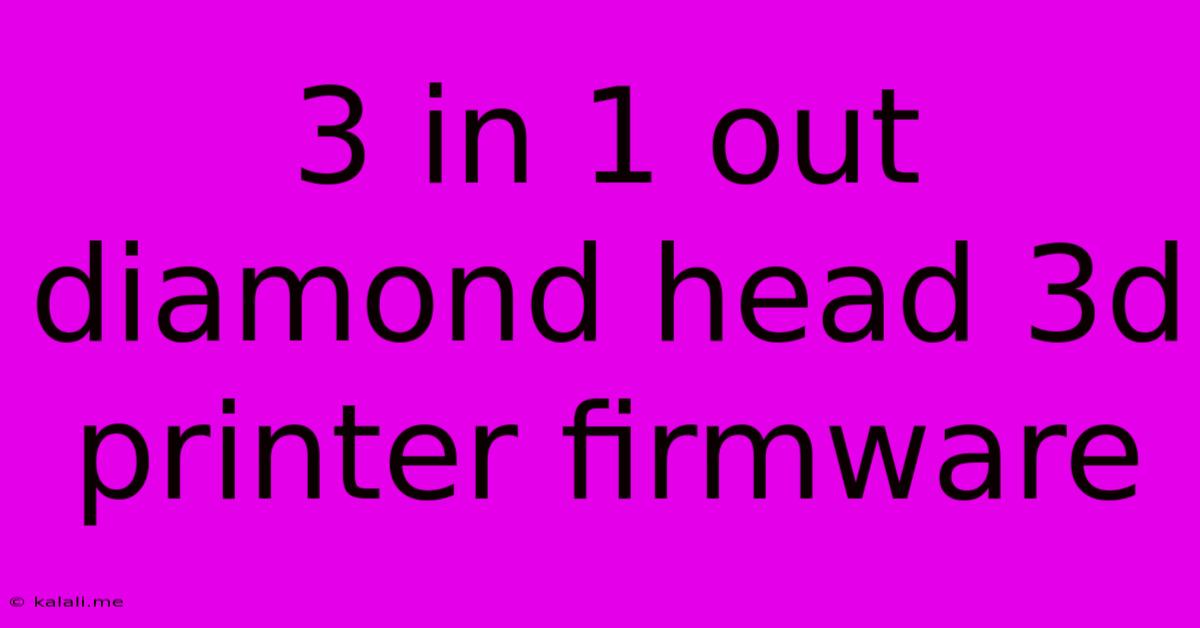3 In 1 Out Diamond Head 3d Printer Firmware
Kalali
May 23, 2025 · 3 min read

Table of Contents
3-in-1 Out Diamond Head 3D Printer Firmware: A Comprehensive Guide
The 3-in-1 out Diamond Head 3D printer boasts impressive capabilities, but maximizing its potential hinges on having the right firmware. This guide delves into the intricacies of 3-in-1 out Diamond Head 3D printer firmware, covering installation, configuration, troubleshooting, and frequently asked questions. Understanding your firmware is crucial for smooth operation, reliable prints, and unlocking advanced features.
Understanding the Importance of Firmware
Firmware is the fundamental software that governs your 3D printer's operations. It acts as the bridge between your computer's instructions and the printer's hardware components, dictating how the printer moves, heats, and extrudes filament. A well-configured firmware ensures precise movements, accurate temperature control, and ultimately, high-quality prints. For a 3-in-1 out Diamond Head, which likely uses multiple extruders for different materials, firmware management is even more critical.
Identifying Your 3D Printer Board and Finding Compatible Firmware
Before diving into installation, it's paramount to identify the specific microcontroller board on your Diamond Head 3D printer. Common boards include, but aren't limited to, those based on the Marlin, Klipper, or RepRap firmware platforms. The type of board determines the compatible firmware version. Consult your printer's documentation or the manufacturer's website for this information. Incorrect firmware installation can severely damage your printer.
Installing the Firmware: A Step-by-Step Guide
The firmware installation process typically involves the following steps:
-
Download: Download the appropriate firmware version for your specific board from a reputable source (likely the manufacturer's site or a well-established 3D printing community forum). Always verify the checksum to ensure the downloaded file is not corrupted.
-
Preparation: Back up your existing firmware if possible. This allows you to revert to the previous version if needed.
-
Flashing: Use a suitable flashing tool (such as Arduino IDE) to upload the new firmware onto the printer's microcontroller board. The exact method varies depending on the board type and the flashing tool. Detailed instructions are usually available in the firmware package or online tutorials specific to your board.
-
Configuration: After flashing, the printer might require some configuration adjustments via the printer's control panel or a configuration file. This often includes calibrating the extruders, setting up bed leveling, and configuring the various printer settings.
Common Firmware Configuration Parameters for Multi-Extruder Systems
Configuring the firmware for a 3-in-1 out Diamond Head will likely involve several key settings:
- Extruder Configuration: Define the number of extruders (3), their types, and their specific settings (e.g., filament diameter, steps per mm).
- Temperature Control: Set the appropriate temperature profiles for each extruder and the heated bed.
- Auto Bed Leveling (ABL): Configure ABL if your printer supports it. ABL is crucial for achieving consistent first layer adhesion.
- Retraction Settings: Fine-tuning retraction settings for each extruder is vital for preventing stringing and oozing.
Troubleshooting Common Firmware Issues
- Printer Not Responding: Check the connections to your board, ensure the power supply is working correctly, and verify the firmware was flashed correctly.
- Inaccurate Extrusion: Verify the extruder steps per mm settings and check for clogs in the nozzles.
- Unexpected Movements: Recalibrate the printer's axes and ensure the configuration file accurately reflects your printer's physical dimensions.
Advanced Firmware Features and Customization
Many firmware platforms offer advanced features like:
- Macros: Create custom macros for recurring tasks.
- Custom G-Code: Write custom G-code for more complex print processes.
- Support for Various Filament Types: Configure the firmware for different filament types (PLA, ABS, PETG, etc.).
Remember, working with firmware can be complex. Always proceed with caution and consult available documentation or community forums for guidance if you encounter any problems. Successful firmware management will significantly enhance your 3D printing experience with your Diamond Head 3-in-1 out printer.
Latest Posts
Latest Posts
-
Aura Lightning Datatable Display Link In The Data
May 23, 2025
-
How To Make Transparent Background Gimp
May 23, 2025
-
Find The Expansion Base Of N Formula
May 23, 2025
-
Nikon D3400 Viewfinder Wont Focus But Live View Works
May 23, 2025
-
Do Plants Give Off Heat Tree Wells
May 23, 2025
Related Post
Thank you for visiting our website which covers about 3 In 1 Out Diamond Head 3d Printer Firmware . We hope the information provided has been useful to you. Feel free to contact us if you have any questions or need further assistance. See you next time and don't miss to bookmark.